 Lobaugh Model Trains began business in 1931, founded by Rollin J. Lobaugh (1895 - 1965), in San Francisco, California.
Rollin J. Lobaugh initially founded his company Pacific Screw & Bolt in 1922 to machine and mill screws, nuts and bolts.
The company was known for being the first west coast based plant to employ screw machines. When the market for the machined
screw products was diminished, Lobaugh decided to mill and sell the 'O' scale (1/4" to the foot) and 7/16" scale
(for 2-1/8" Standard gauge track) model train parts that were distributed as kits and ready-to-run factory assembled scale
models. Locomotives were designed for 2-rail electric operation, but could be converted for 3-rail. The company built a
reputation for providing high quality clean cut punched sheet metal parts, sharp bronze castings, and fine scale turnings
of small detail parts. The train models produced were not toys. They were scaled down replicas of real steam locomotives
that operated on prototypical railroads from that era. Lobaugh pioneered features in scale modeling such as individually
sprung bearings, an enclosed gearbox, lost-wax castings and a two rail pick-up that utilized the engine for one contact and
the tender for the other. The business was located at 1179 Howard Street in San Francisco.
Lobaugh Model Trains began business in 1931, founded by Rollin J. Lobaugh (1895 - 1965), in San Francisco, California.
Rollin J. Lobaugh initially founded his company Pacific Screw & Bolt in 1922 to machine and mill screws, nuts and bolts.
The company was known for being the first west coast based plant to employ screw machines. When the market for the machined
screw products was diminished, Lobaugh decided to mill and sell the 'O' scale (1/4" to the foot) and 7/16" scale
(for 2-1/8" Standard gauge track) model train parts that were distributed as kits and ready-to-run factory assembled scale
models. Locomotives were designed for 2-rail electric operation, but could be converted for 3-rail. The company built a
reputation for providing high quality clean cut punched sheet metal parts, sharp bronze castings, and fine scale turnings
of small detail parts. The train models produced were not toys. They were scaled down replicas of real steam locomotives
that operated on prototypical railroads from that era. Lobaugh pioneered features in scale modeling such as individually
sprung bearings, an enclosed gearbox, lost-wax castings and a two rail pick-up that utilized the engine for one contact and
the tender for the other. The business was located at 1179 Howard Street in San Francisco.
 The 1935 catalog was illustrated and carried 1/4" scale freight and passenger car parts, construction kits,
finished cars, finished locomotives, parts and construction kits for track materials, track-side accessories, the 7/16" scale
track and car parts and the hexagon screws and nuts. It was 40 pages long and cost $.25 a copy (refundable with a first
order). Hobbyists could purchase all sorts of pressed metal parts, such as box car braces, gondola braces, stake pockets,
ladders, box car steps, reefer door hinges, and brake wheels. The company also produced brass rail, rail joiners, tie plates
and spikes that were purchased by hobbyists for both electric as well as live-steam layouts and basement railroads. The
painstaking 'Lost Wax' casting process was employed for the manufacture of many Lobaugh parts.
The 1935 catalog was illustrated and carried 1/4" scale freight and passenger car parts, construction kits,
finished cars, finished locomotives, parts and construction kits for track materials, track-side accessories, the 7/16" scale
track and car parts and the hexagon screws and nuts. It was 40 pages long and cost $.25 a copy (refundable with a first
order). Hobbyists could purchase all sorts of pressed metal parts, such as box car braces, gondola braces, stake pockets,
ladders, box car steps, reefer door hinges, and brake wheels. The company also produced brass rail, rail joiners, tie plates
and spikes that were purchased by hobbyists for both electric as well as live-steam layouts and basement railroads. The
painstaking 'Lost Wax' casting process was employed for the manufacture of many Lobaugh parts.
 The first locomotives were a Rock Island 2-8-2 Mikado, an SP 4-8-2 Mountain, and an 0-6-0 SP switcher that appeared
in 1937. The switcher model was actually in 17/64 scale, which is just slightly larger than 'O' scale. Lobaugh locomotives
were constructed of heavy brass sheeting, cast red-art bronze frames and were fitted with cast iron drive wheels. Brass
tube boilers included full rivet details and frames were available fully machined or un-machined.
The first locomotives were a Rock Island 2-8-2 Mikado, an SP 4-8-2 Mountain, and an 0-6-0 SP switcher that appeared
in 1937. The switcher model was actually in 17/64 scale, which is just slightly larger than 'O' scale. Lobaugh locomotives
were constructed of heavy brass sheeting, cast red-art bronze frames and were fitted with cast iron drive wheels. Brass
tube boilers included full rivet details and frames were available fully machined or un-machined.

In 1939 Rollin J. Lobaugh offered an 'O' scale model of the 4-6-6-4 articulated UP Challenger locomotive
built and designed using the actual prototype blueprints, but reduced to 1/48th the size. This was a big engine (31.5" long)
that could run on 4 foot radius curves. The loco featured a #4 K&D motor that powered all 12 driving wheels. Each driver was
sprung, and the advertising materials touted that the loco could pull as many as 38 cars over a 3% grade, with virtually
unlimited pulling power on level track. It was priced in the 1939 catalogue at $162.50 for a complete kit or assembled
ready-to-run for $225. This was a pretty hefty price for a model train in 1939. Lobaugh justified his prices based on the
level of effort that went into the development of this model. Engineering staff conducted detailed research
in the design phases and determined that using a 23:1 gear ratio would provide the smoothest starts and highest torque
at low speeds under full load, without impairing the high, free rolling top speed of this locomotive model.

Lobaugh supplied rolling stock and motive power, including one of its 4-6-6-4 Challengers for the operating 2-rail
Santa Fe layout built by Minton Cronkhite and displayed at the 1939 San Francisco World's Fair held on Treasure Island (also
known as the Golden Gate International Exposition). Another famous layout that was designed and built by Minton
Cronkhite in 1939 was the 50-by-60-foot 'O' scale 'Museum & Santa Fe Railway' housed for over
60 years at the Museum of Science and Industry in Jackson Park in Chicago. Lobaugh Scale Models of California built about
30 of the freight cars that ran on this layout. The cars all had Bakelite wheels and non-operating couplers, and every car
was lettered for the ATSF.


 Between 1939 and 1941 the Lobaugh line was expanded further to include scale models of 4-6-6-4 Union
Pacific, Delaware & Hudson and Northern Pacific Challengers, a 2-8-4 Chicago and North Western Berkshire, a 4-8-4 J3A
Greenbrier, a Baltimore & Ohio 4-6-2 Pacific, a Boston and Maine 4-4-0, and a 4-8-2 Missouri Pacific Mountain. The Lobaugh
Mountains are fairly rare, having only been produced for three years before WWII. They were also very expensive for the
average 1938 model railroader costing $195 for a finished locomotive, and over $100 for a kit. By 1941 Lobaugh offered an
astounding 11 locomotive kits ranging from the 4-4-0 to the 4-6-6-4 Challenger and just about every wheel arrangement in
between. Lobaugh also produced a Suburban Tank, and a ten-wheeler. The 1941 catalog was 76 pages and announced the newly
manufactured Baltimore & Ohio 4-6-2 Pacific's and the Delaware & Hudson 4-6-6-4. It is believed that in 1941 an 'O' scale
4-8-4 Southern Pacific Daylight GS-3 was planned and advertised, but was never actually produced, as none have ever been
discovered. However, in 1941 Lobaugh did deliver the AC-8 Cab Forward around the time of the outbreak of WW2. There are
very few of these models in existence as part production ceased during wartime, making them the rarest of all Lobaugh
models (less than a dozen made).
Between 1939 and 1941 the Lobaugh line was expanded further to include scale models of 4-6-6-4 Union
Pacific, Delaware & Hudson and Northern Pacific Challengers, a 2-8-4 Chicago and North Western Berkshire, a 4-8-4 J3A
Greenbrier, a Baltimore & Ohio 4-6-2 Pacific, a Boston and Maine 4-4-0, and a 4-8-2 Missouri Pacific Mountain. The Lobaugh
Mountains are fairly rare, having only been produced for three years before WWII. They were also very expensive for the
average 1938 model railroader costing $195 for a finished locomotive, and over $100 for a kit. By 1941 Lobaugh offered an
astounding 11 locomotive kits ranging from the 4-4-0 to the 4-6-6-4 Challenger and just about every wheel arrangement in
between. Lobaugh also produced a Suburban Tank, and a ten-wheeler. The 1941 catalog was 76 pages and announced the newly
manufactured Baltimore & Ohio 4-6-2 Pacific's and the Delaware & Hudson 4-6-6-4. It is believed that in 1941 an 'O' scale
4-8-4 Southern Pacific Daylight GS-3 was planned and advertised, but was never actually produced, as none have ever been
discovered. However, in 1941 Lobaugh did deliver the AC-8 Cab Forward around the time of the outbreak of WW2. There are
very few of these models in existence as part production ceased during wartime, making them the rarest of all Lobaugh
models (less than a dozen made).
Lobaugh 'O' Scale Kit-built 2-rail 40' Refrigerator Cars
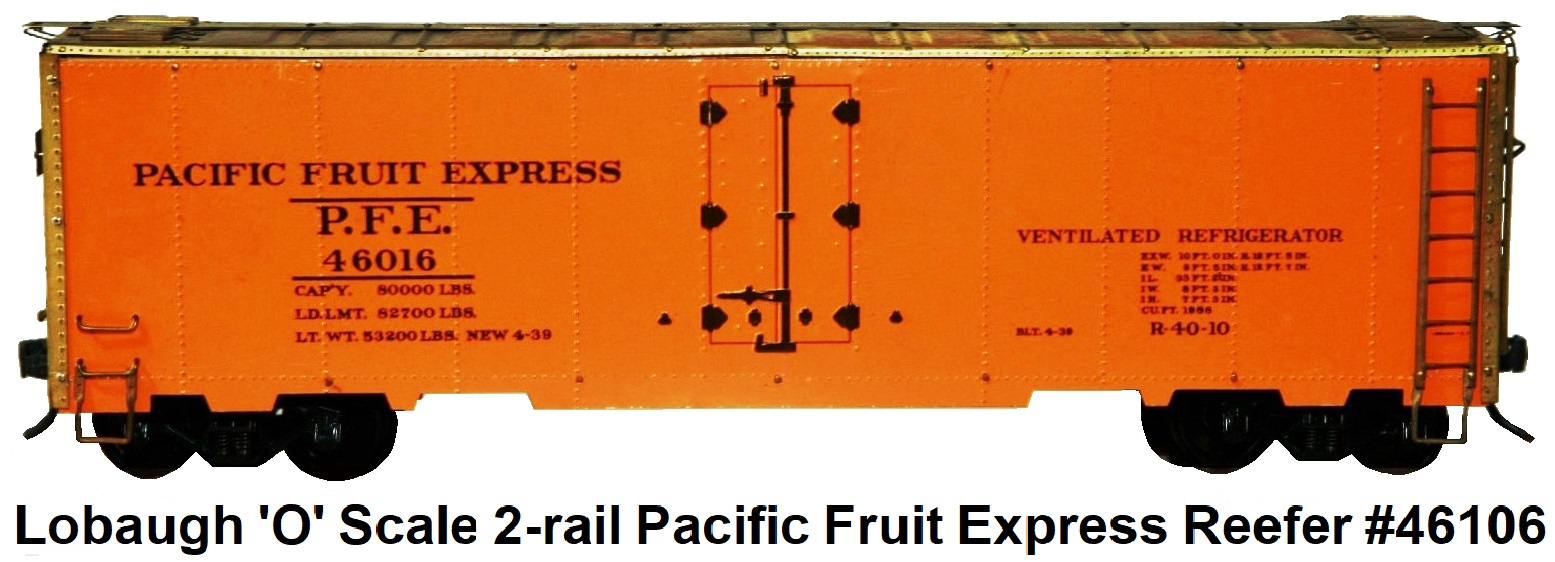

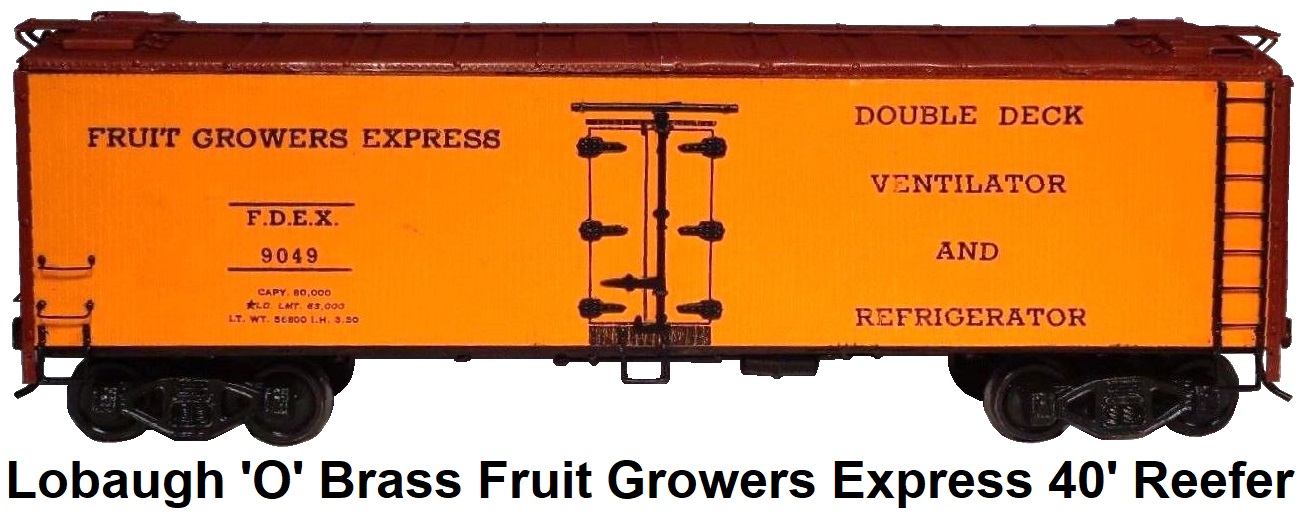
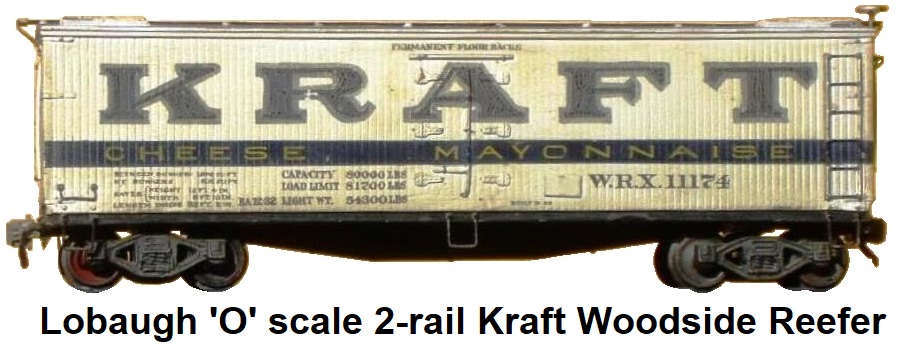
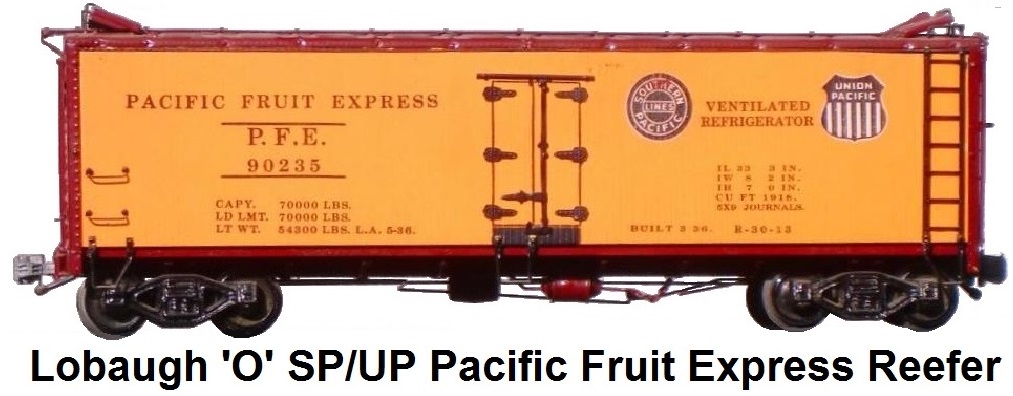


Lobaugh also made and distributed over 120 different freight car kits. One very unique item that was not produced by
other manufacturers was the Lobaugh 65' mill gondola. Lobaugh Freight cars were available in ¼" or
17/64" scale. Prior to 1940 all cars had wood sides and roof. All wooden bodies supplied in the
construction kits came seasoned, cut to size and pre-fitted. The early kits also included lacquer for painting the cars,
and certain kits marked with an asterisk, included decalmanias for lettering. After 1940 they switched to steel sides for
the majority of their freight car offerings. The later metal-sided cars came with silk screen lithography which produced
clear, detailed and appealing box car and ice car sides. The Lobaugh catalogs proclaimed that, "all cars except tank cars
could be built with the usual hand tools but the use of a drill press is recommended". The Lobaugh box cars and reefers
somewhat resemble the original 'O' scale Athearn products but Lobaugh made his own parts so there
are differences. The Lobaugh box car roofs are two piece and the frames include draft gear. The included trucks were fully
assembeled and featured automatic couplers. For an extra cost, Lobaugh offered several options such as factory-built and
finished with decals or finished and hand lettered freight car models. Lobaugh 'O' scale cars are sturdy and appear
authentic for the 1930's-40's era they were actually built in. They don't have the exaggerated detail of late 20th and
early 21st century Atlas, MTH or Lionel cars but
the thin metal construction of the later offerings makes them seem more realistic.
Lobaugh 'O' Scale Kit-built 40' Box Cars
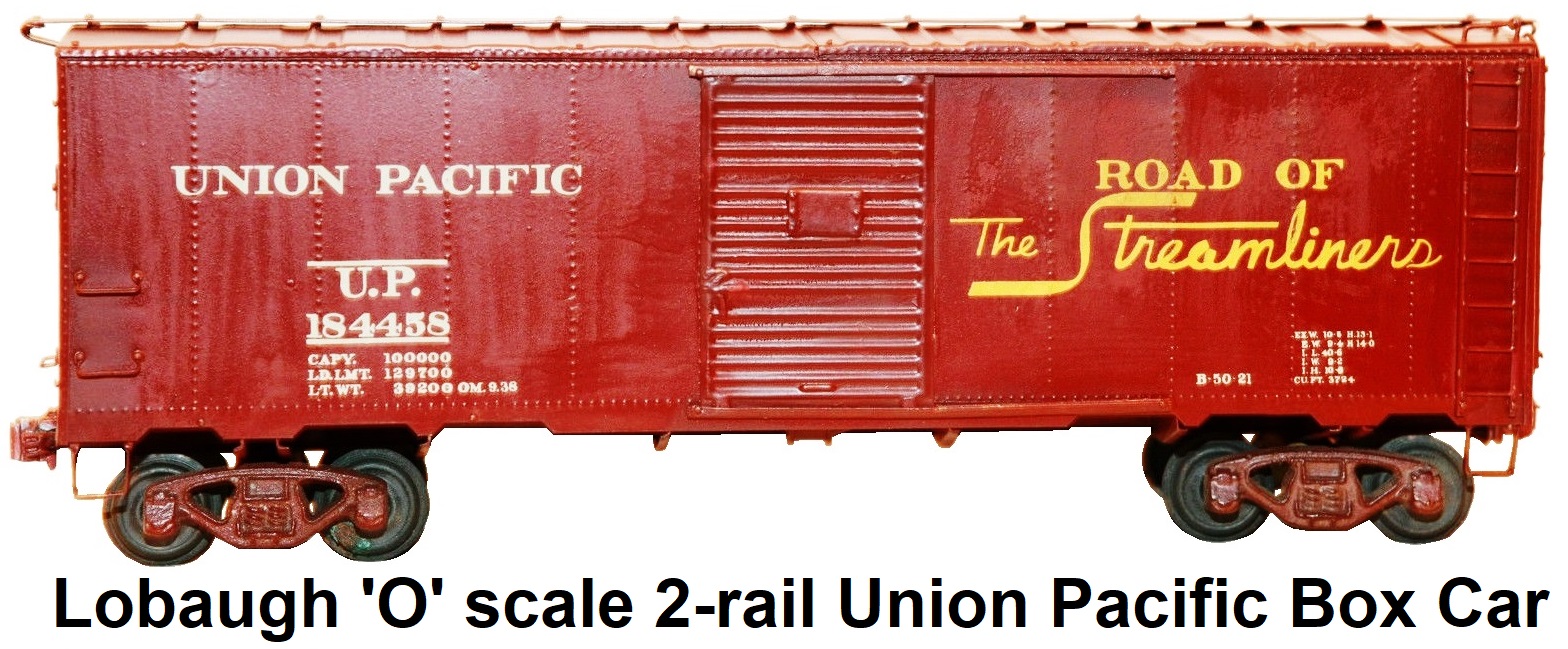
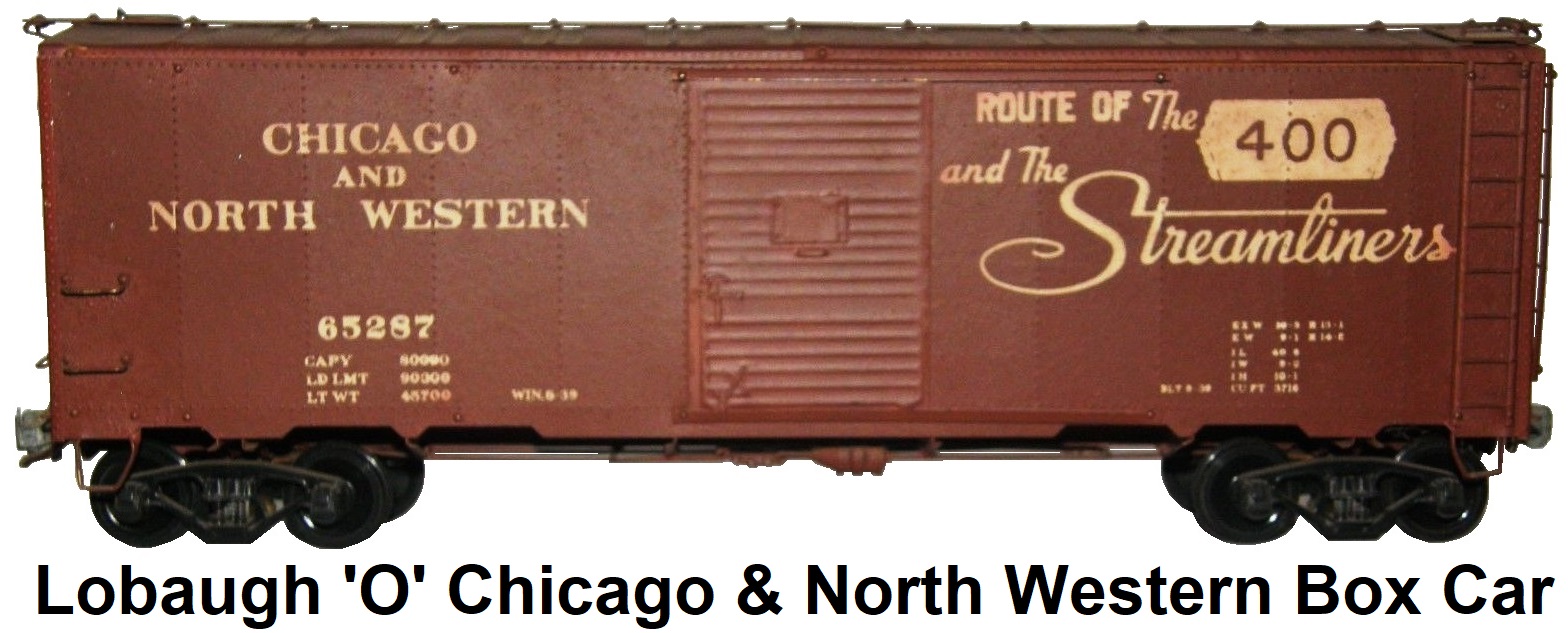
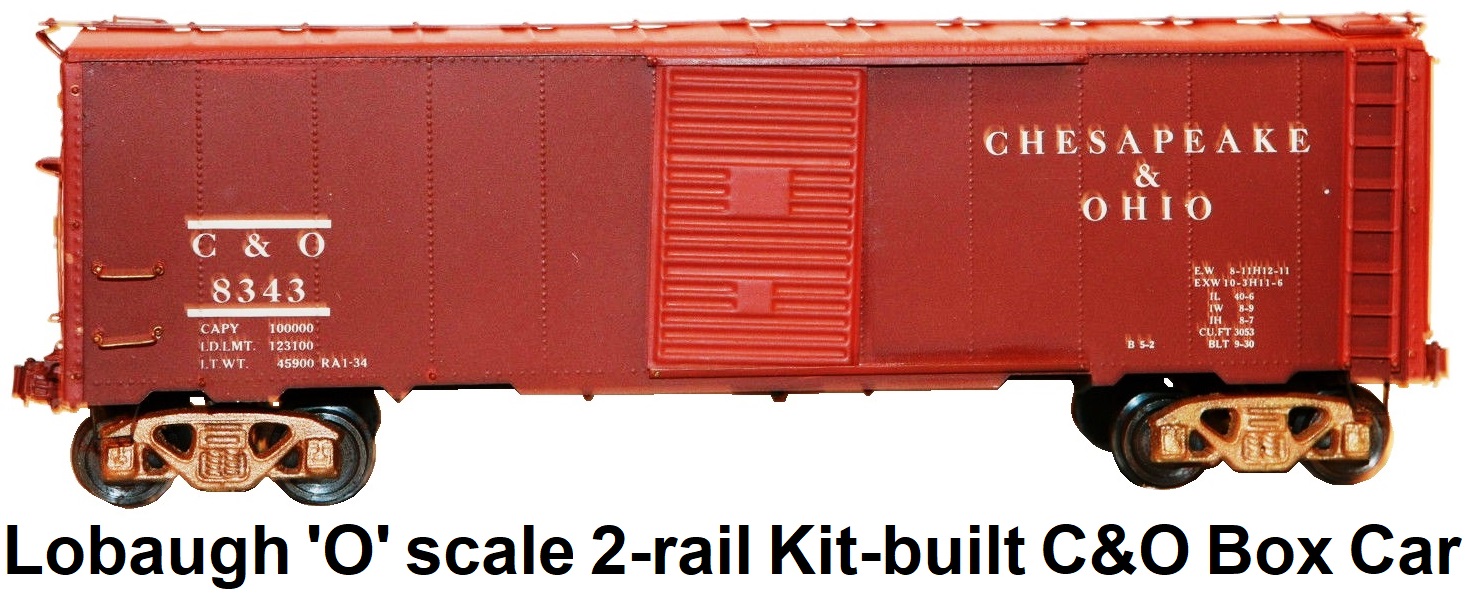
The 1940 Lobaugh catalog informed potential buyers that the 10,000 gallon tank cars were entirely made of
metal consisting of brass tubing with pressed metal ends that were formed and turned to fit the tube. Domes were
made of cast bronze and the running boards were sheet brass. Complete painted and decorated models that
were ready-to-run were priced at $14.75 each. Kit versions were listed at $7.75. The 1953 catalog listed 17 different
tank car offerings. Some were listed as $22 built-up/$11 in kit form, while a platform dome version was a bit more costly
at $23 built-up/$11.20 as a kit. Road names included Anchor, Barrett Tarvia, Cities Service, Crystal Car Lines, Conoco,
Deep Rock, Pennsylvania, Philgas, Shell, Union Tank Line, Texaco and Warren. Pre-war tank cars had a row of rivets at
each end, as did the Vanderbilt tender for the Mikado loco. The post-war era tube tank cars had no rivets. When Lobaugh
began using wrappers for decoration, the tank car rivet detail became slightly more extensive.
Lobaugh 'O' Scale Kit-built Tank Cars
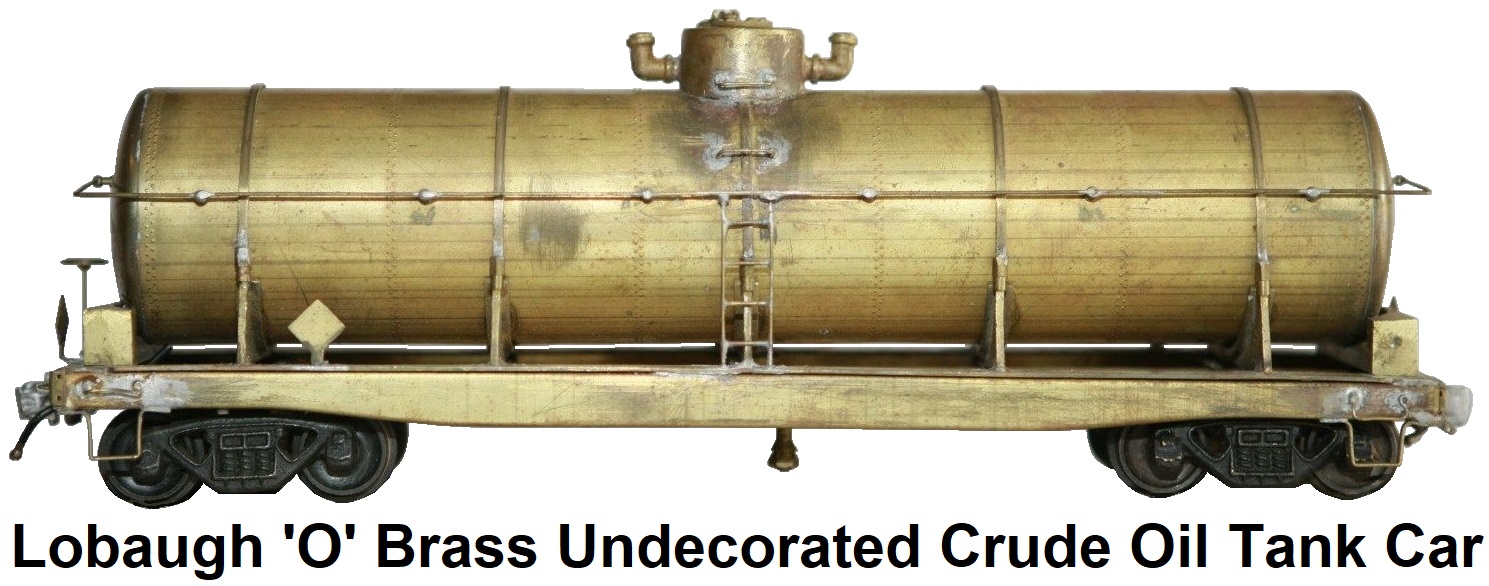
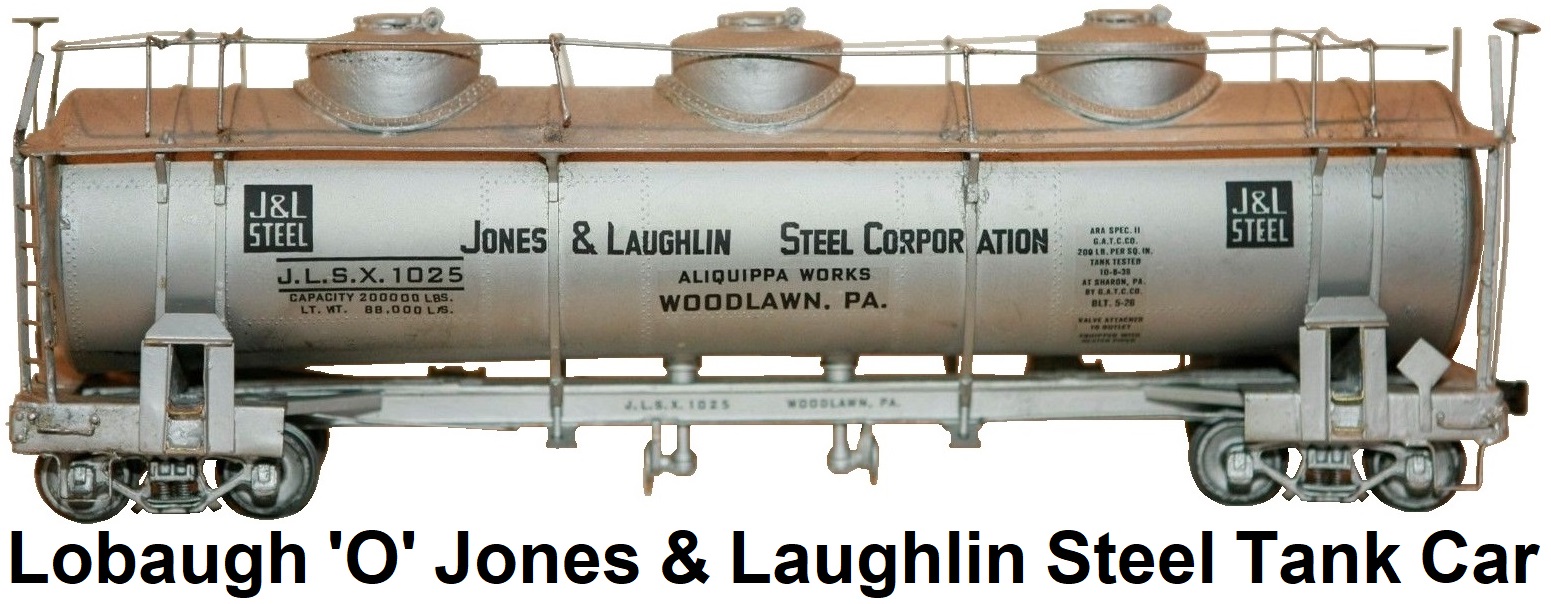
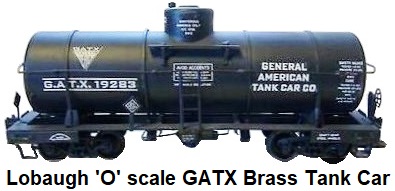
The Lobaugh cupola caboose was offered as either a Santa Fe type with low cupola, or as an
A.T.&S.F. type with high cupola and large tool box. These were also entirely made of sheet brass and steel, with
complete details, including embossed rivets on the car body, and an underbody frame that was also nicely finished.
In addition to the freight kits, Lobaugh marketed two
passenger car kits. A Pullman kit that came either hand lettered or decaled, and a Combination Baggage/Mail car. These
were available as finished metal sides, pressed kits, finished board sides or mounting kits. The car ends were bronze sand
castings and the sides were stamped steel. All the other major parts were wood. Lobaugh production was primarily the steam
locomotives and freight cars. Rather than producing scale diesels and streamlined cars, Lobaugh opted to offer the
Santa Fe AB EMD diesels and Budd type passenger cars made by the Pomona Valley Model Supply Co. of La Verne, CA. in
the Lobaugh 1941 catalog.


Lobaugh offered a 'Warrantee of Fine Craftsmanship' stating, "Any purchaser of Lobaugh equipment who
is not satisfied will, upon return of the equipment within thirty days, receive a refund of the full purchase price, plus
a refund of all transportation costs paid by the purchaser.” Rollin Lobaugh liked to boast that no one had ever taken him
up on his offer. Lobaugh also touted itself in advertising materials and catalogues as "the aristocrat of 'O' gauge" and
the "standard by which other model railroad equipment is judged". The Lobaugh logo emphasized 'Micrometer Precision'.
 After World War II train production was resumed, but initially in a limited fashion. The Baltimore and Ohio Pacific was
converted to a more generic USRA design. The 0-6-0 SP switcher was re-made, now cast in lost wax 1/4 inch scale. The
Berkshire and 4-4-0 were also kept in the product line, but all other models were dropped.
After World War II train production was resumed, but initially in a limited fashion. The Baltimore and Ohio Pacific was
converted to a more generic USRA design. The 0-6-0 SP switcher was re-made, now cast in lost wax 1/4 inch scale. The
Berkshire and 4-4-0 were also kept in the product line, but all other models were dropped.
In 1953 the company moved to a newly built facility located at 930 Linden Avenue in South San Francisco.
1953 also witnessed the release of the Chesapeake & Ohio 4-8-4. Any model railroader visiting the west coast was invited to
tour and inspect the new plant. By this time the company had 45 employees. Lobaugh 'O' scale model production reached its
peak around the mid 1950's. The 1955 catalogue showed an increase of products offered in the line and was 32 pages long. It
featured the UP 4-6-6-4 #3900 series Challenger now priced at $196 for a complete kit, the C & NW 2-8-4 Berkshire in kit form
for $110.50, a C&O 4-8-4 Greenbrier priced at $146 for a complete kit, the SP 0-6-0 switcher for $77.50 in a complete kit,
the New Haven 4-4-0 complete kit for $69.50, a Climax Logging loco complete kit for $97.50, and a USRA 4-6-2 Pacific offered
with either a square ($98.50 complete kit) or Vanderbilt ($102.50 complete kit) tender. Lobaugh had developed and now offered
their own 18 volt AC or 12 volt DC motors in 3 versions, all with 9 slot-balanced armatures, wound with Formex wire,
featuring an enclosed brush design, and oversize Oilite bearings. Drive shafts were worm type and featured enclosed ball
bearings. Traction driver axles were fitted with Bakelite gears on steel hubs. Rolling stock offered consisted of Milwaukee
50' steel sheathed auto box car kits for $11.25, Milwaukee 40' box car kits for $10, B&O Wagon Top box car
kits for $11.40, 40' AAR box car kits for $10.25, a Santa Fe type caboose kit for $15.90, a Southern Pacific type caboose
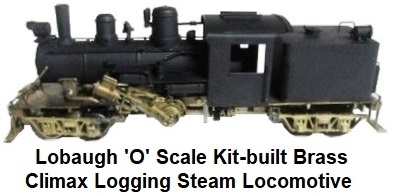 kit also $15.90, a 50' flat car kit for $10.50, an H.J. Heinz tanker kit for $11.30, a logging flat kit at $4.50 (3 for
$12.50), an AAR class GB Gondola kit
for $10, a 65' Mill-type gondola kit at $13.50, a 50' steel reefer kit for $12, a 3-dome 20,000 gallon tank car kit for $13
and a single dome 12,400 gallon oil tanker kit for $11.50. The catalogue also featured several pages of individual parts
such as locomotive valve gear, machined and insulated driver castings, spoked wheels, diesel locomotive wheels, crank pins,
axles, bearings, running boards, cylinders, bells, generators, boiler assemblies, cab assemblies, guides, cross heads,
collectors, headlights, drawbars, domes, caps, hoses, pilots, stacks, steps, trucks, etc., and the hexagon head screws, nuts
and washers they were famous for. Lobaugh even offered 15 different 'O' gauge cast brass hand-painted railroad figures.
kit also $15.90, a 50' flat car kit for $10.50, an H.J. Heinz tanker kit for $11.30, a logging flat kit at $4.50 (3 for
$12.50), an AAR class GB Gondola kit
for $10, a 65' Mill-type gondola kit at $13.50, a 50' steel reefer kit for $12, a 3-dome 20,000 gallon tank car kit for $13
and a single dome 12,400 gallon oil tanker kit for $11.50. The catalogue also featured several pages of individual parts
such as locomotive valve gear, machined and insulated driver castings, spoked wheels, diesel locomotive wheels, crank pins,
axles, bearings, running boards, cylinders, bells, generators, boiler assemblies, cab assemblies, guides, cross heads,
collectors, headlights, drawbars, domes, caps, hoses, pilots, stacks, steps, trucks, etc., and the hexagon head screws, nuts
and washers they were famous for. Lobaugh even offered 15 different 'O' gauge cast brass hand-painted railroad figures.
Compared to the detailed imported 'O' scale models of the 21st century many Lobaugh locomotives may seem crude, and they
were in regard to fine details, but they were mechanical masterpieces. Many are still running today. Lobaugh produced models
from 1931 through 1965, first under Rollin Lobaugh himself and then under Al Ellis, the chief engineer, builder and designer
who took over the scale model train company in 1956. Ellis was credited with producing the modern Jabelmann Challenger, the
Climax Logging Loco, the suburban tank, a Mogul, and the Chesapeake & Ohio Greenbrier.
 Since then the Lobaugh line, inventory and original tooling has passed through many hands over the years, getting split
here and there. An employee of Al Ellis named Jack Campbell purchased the scale model company in 1959. Campbell had been
handling sales and shipping orders starting in 1958. Then in December 1982 the scale model business was acquired by Allen
Drucker, owner of Allied Model Trains in Los Angeles. Later in 1983 Drucker sold the company to Jan Lorenzen and Vince
Waterman who split it up. Two thirds of the parts and all of the dies except for the 4-4-0 Climax and
Rollin Lobaugh's drill press went to Lorenzen of the Locomotive Workshop of Avon Lake, Ohio. Vince Waterman of Trackside
Specialties of Trafford, Alabama retained the molds for the 4-4-0 Climax and the remaining third of parts including frames,
drivers, lathe, and Rollin Lobaugh's drill press. However, in 1996 Vince sold the balance of parts back to Jan Lorenzen.
Bob Stevenson of Stevenson Preservation Lines of
Burlington, Illinois and Boone, Iowa bought all the dies and molds from Locomotive Workshop in 2001. This last company
probably has the most extensive collection of parts and castings and has resurrected the Lobaugh SP Mikado kit, the Climax
Logging engine kit, the SP S-12 0-6-0 switcher kit and the Vanderbilt tender kit.
Since then the Lobaugh line, inventory and original tooling has passed through many hands over the years, getting split
here and there. An employee of Al Ellis named Jack Campbell purchased the scale model company in 1959. Campbell had been
handling sales and shipping orders starting in 1958. Then in December 1982 the scale model business was acquired by Allen
Drucker, owner of Allied Model Trains in Los Angeles. Later in 1983 Drucker sold the company to Jan Lorenzen and Vince
Waterman who split it up. Two thirds of the parts and all of the dies except for the 4-4-0 Climax and
Rollin Lobaugh's drill press went to Lorenzen of the Locomotive Workshop of Avon Lake, Ohio. Vince Waterman of Trackside
Specialties of Trafford, Alabama retained the molds for the 4-4-0 Climax and the remaining third of parts including frames,
drivers, lathe, and Rollin Lobaugh's drill press. However, in 1996 Vince sold the balance of parts back to Jan Lorenzen.
Bob Stevenson of Stevenson Preservation Lines of
Burlington, Illinois and Boone, Iowa bought all the dies and molds from Locomotive Workshop in 2001. This last company
probably has the most extensive collection of parts and castings and has resurrected the Lobaugh SP Mikado kit, the Climax
Logging engine kit, the SP S-12 0-6-0 switcher kit and the Vanderbilt tender kit.
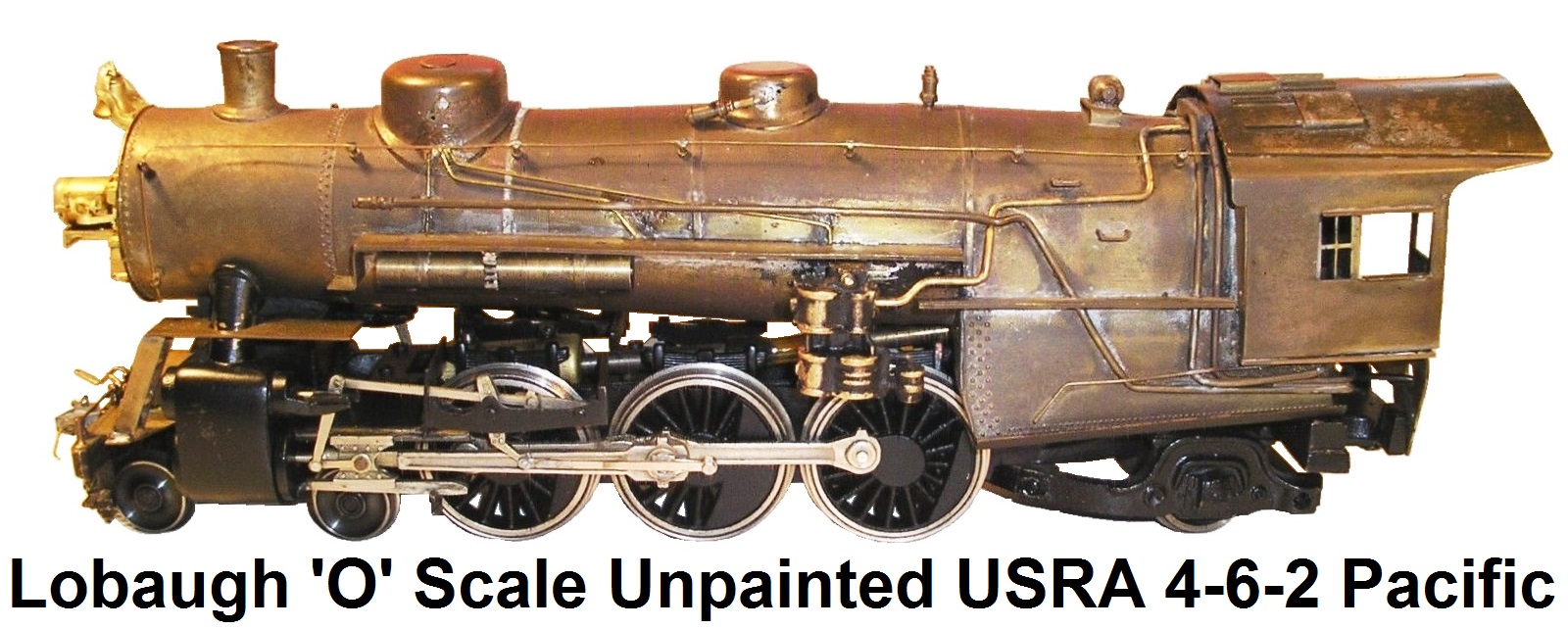 There are serious Lobaugh collectors and operators in the hobby world
today. 70+ year old Lobaugh trains and brass kits frequently show up on eBay for sale at very high prices. Scale railroading
hobbyists tended to modify and render the scale kits to satisfy their own desires for modeling the railroad prototypes they
favored, so there is great variance and customization in the features, heralds, paint schemes, etc. of the Lobaugh trains
that do come on the market. Modelers who scratch-build locomotives utilize original Lobaugh locomotive boiler castings
or cast parts that show up with drivers, trucks, couplers, cabs, pilots, brass fittings, tenders
and motors originally made by other 'O' scale kit and parts manufacturers such as Varney,
All-Nation, Scale-Craft, Atwater, Megow, Kadee,
General Models Corp. and Walthers. More advanced model builders also
tended to machine their own castings, when the ones needed for their custom prototypical builds were not readily available
from vendors. These 'mixed breed' scale models tend not to be worth as much as a complete kit assembled from a single
manufacturer, but they provide a degree of railroad realism not normally attainable otherwise.
There are serious Lobaugh collectors and operators in the hobby world
today. 70+ year old Lobaugh trains and brass kits frequently show up on eBay for sale at very high prices. Scale railroading
hobbyists tended to modify and render the scale kits to satisfy their own desires for modeling the railroad prototypes they
favored, so there is great variance and customization in the features, heralds, paint schemes, etc. of the Lobaugh trains
that do come on the market. Modelers who scratch-build locomotives utilize original Lobaugh locomotive boiler castings
or cast parts that show up with drivers, trucks, couplers, cabs, pilots, brass fittings, tenders
and motors originally made by other 'O' scale kit and parts manufacturers such as Varney,
All-Nation, Scale-Craft, Atwater, Megow, Kadee,
General Models Corp. and Walthers. More advanced model builders also
tended to machine their own castings, when the ones needed for their custom prototypical builds were not readily available
from vendors. These 'mixed breed' scale models tend not to be worth as much as a complete kit assembled from a single
manufacturer, but they provide a degree of railroad realism not normally attainable otherwise.
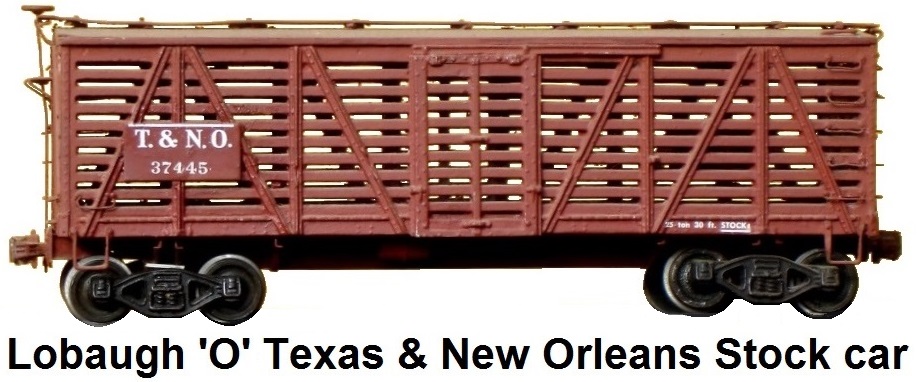





Rollin J. Lobaugh was elected to the 'O' Scale Hall of Fame in 1995 at the 'O' nationals in New Jersey. In 1996, he was
enrolled in the Model Railroad Industry Association (MRIA) Hall of Fame and was posthumously awarded the National
Model Railroad Association (NMRA) Pioneer Award in 2013. Rollin J. Lobaugh was one of the pillars of the 'O' scale community.
Lobaugh had collaborations with, at one time employed, or resold and acquired machined parts from many other 'O' scale
pioneers such as Jerry White and Bill J. Lenoir. The Rollin J. Lobaugh Company founded by Rollin J. Lobaugh in 1922 still
exists and operates today in South San Francisco, providing precision machining services using modern day CNC tools.
